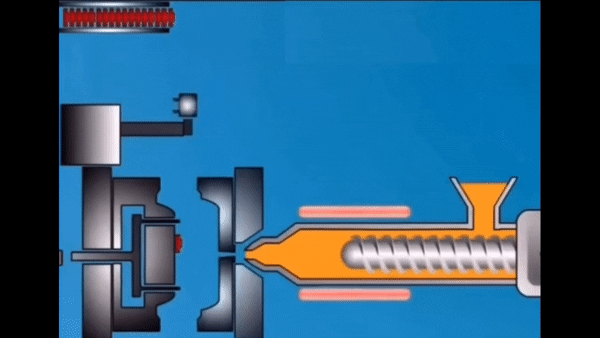

Welcome to moldtechpro. Dive deep into the world of Insert molding with us. Explore our detailed guide below.

Introduction to Insert Molding:
Insert molding is a specialized process that involves encapsulating a pre-formed component, known as an insert, into molten plastic using an injection molding machine. The insert, which can be made of metal, glass, wood, fiber, rubber, or already molded plastic parts, is first placed into the mold at a designated position, after which the molten plastic is injected into the mold. The most common inserts are made of metal, such as threaded rods or electrodes. Once the mold is opened after the plastic has cooled and solidified, the insert is tightly encapsulated within the molded plastic, resulting in a single assembled piece with the insert integrated into it.
Strength and Durability: The combination of plastic’s moldability and elasticity with metal’s rigidity and strength results in products that are robust, durable, and heat-resistant.
Cost Savings: Insert molding eliminates the need for secondary operations like welding and riveting, reducing assembly time and costs.
Reduces Assembly and Labor Costs: By integrating components and eliminating complex tasks such as arranging sealing rings, the process facilitates automation of subsequent assembly operations.
Enables Combination of Metal and Plastic Components: This increases the design flexibility of the products, opening up new possibilities for combining plastic, metal, and other materials like fabric, paper, wire, glass, wood, and coils.
Enhances Component Design: The inclusion of metal or other inserts in plastic components not only increases the strength of the plastic parts but also allows for the creation of products with special requirements such as magnetism, wear resistance, fastening, and electrical functionality.
Improved Reliability and Testing: The fusion of molten plastic with metal inserts allows for narrower gaps between metal inserts compared to press-fit methods, resulting in higher product reliability and easier passage of vibration tests.
Protection of Fragile Components: Appropriate plastics and molding conditions can securely seal and fix even fragile components like glass, coils, and electrical parts.
Lighter and Smaller Products: Combining materials allows for the creation of integrated metal-plastic products that are lighter and smaller in size.
By combining the benefits of different materials and eliminating secondary operations, insert molding enhances the design, functionality, and reliability of products while reducing manufacturing time and costs.
Higher Initial Costs: The initial setup costs for insert molding can be higher due to the need for specialized molds and the requirement of inserts.
Material Compatibility: There may be challenges related to the compatibility of the insert material with the plastic, such as differences in thermal expansion rates, which can lead to product defects if not properly addressed.
Complexity in Design: The design process can be more complicated as it needs to account for the integration of different materials, the insert placement, and the molding process.
Limited to Certain Materials: Not all materials are suitable for insert molding. Some materials may not withstand the heat and pressure involved in the molding process.
Process Control: Maintaining precise control over the molding process is crucial to ensure that the inserts remain in the correct position during molding and that the finished product meets quality standards.
Tooling and Equipment: Specialized tooling and equipment are needed for insert molding, which may not be readily available or may require customization.
Lead Time: The lead time for developing the mold and the initial setup can be longer compared to standard injection molding.
Remember, while these are potential disadvantages, they may not apply in all cases and can often be mitigated with careful planning and process control.

Medical Industry
In the medical field, insert molding is used to manufacture components of medical devices, such as handles for surgical instruments, where a metal insert is encapsulated with a plastic material to ensure a comfortable grip and durability.

Automotive Industry
It is extensively used in the automotive sector to create parts like knobs, dials, and electronic components. For instance, it can be used to mold plastic around a metal screw, forming a secure and durable knob for adjusting car seats.

Consumer Goods
Everyday consumer goods such as electrical plugs, toothbrushes, and kitchen appliances often incorporate components made using insert molding.

Electronics Industry
This process is also prevalent in the electronics industry for manufacturing components like connectors with metal pins, or encapsulating wire terminations with plastic to ensure electrical insulation and mechanical strength.
At MoldTechPro, our mastery in insert molding products production permeates various sectors. We tailor high-quality solutions to meet diverse industry needs, showcasing our broad expertise and commitment to your success.









Selecting the appropriate materials for both the insert and the plastic is a crucial step in the insert molding process. The materials must be compatible with each other to ensure a strong bond and optimum performance of the final product.
The insert material is often a metal, but it can also be glass, wood, fiber, paper, rubber, or another plastic component. The most common insert material is metal. When selecting an insert material, consider its thermal expansion, conductivity, and the strength required for the final application. For instance, stainless steel inserts are commonly used for their strength and resistance to corrosion.
The plastic material must be selected based on its melting temperature, chemical resistance, and mechanical properties. Commonly used plastics for insert molding include thermoplastic materials like Polypropylene (PP), Polyethylene (PE), Acrylonitrile Butadiene Styrene (ABS), and Polycarbonate (PC).

ABS

Glass Fiber Reinforced Plastics

PPS
It is essential to ensure that the selected insert and plastic materials are compatible. Material compatibility is influenced by several factors:
Thermal Expansion: The coefficient of thermal expansion of the insert and plastic materials should be as close as possible to prevent deformation or failure due to temperature changes during the molding process or in the final application.

Chemical Interaction: There should be no adverse chemical reactions between the insert and plastic materials during the molding process or throughout the life of the product.
Adhesion: The plastic material should adequately adhere to the insert material to form a strong bond. Surface treatments, like plating or roughening the insert surface, can improve adhesion.
Designing parts for insert molding requires careful consideration of various factors to ensure a successful molding process and a high-quality final product. Here are some guidelines and tips for designing parts for insert molding:
Size and Shape: The size and shape of the insert are crucial for a successful insert molding process.

Surface Treatment: Surface treatments are crucial to improving the adhesion between the insert and the plastic. Some of the common treatments include:


Preparation: The insert, often made of metal, needs to be cleaned and treated to ensure proper adhesion to the plastic during the molding process.
Insert Placement: The prepared insert is placed into the injection mold at the designated position. The mold is designed to hold the insert securely in place during the molding process.
Plastic Injection: Molten plastic is injected into the mold, surrounding and encapsulating the insert. The high temperature of the plastic aids in bonding it to the insert.
Cooling: The mold is then cooled, allowing the plastic to solidify and adhere to the insert.
Ejection: Once the plastic has completely solidified, the finished part, now encapsulated with the insert, is ejected from the mold.

Material Cost: The cost of the plastic material and the inserts. The selection of material can have a significant impact on the cost. Using common, readily available materials can help reduce the cost. However, it is important to ensure that the material selected meets the performance requirements of the final product.
Mold Cost: The cost of designing and manufacturing the mold. This can be a significant portion of the overall cost. To minimize mold cost:
Production Cost: The cost of actually producing the parts. This includes the cost of machine time, labor, and any post-processing required. To minimize production cost:
Surface Treatment Cost: The cost of any surface treatments required to improve the adhesion between the insert and the plastic.
Quality Control Cost: The cost of inspecting and testing the parts to ensure they meet the required quality standards.
Getting a Quote:
To get a quote for insert molding, you will need to provide the following information:
Requirement Gathering
Gathering detailed information from the customer about their specific product requirements, including design specifications, dimensions, functionality, and any special features or considerations
Design and Engineering
We will work closely with the customer to develop a mold design that meets their requirements. This includes creating 3D CAD models, performing feasibility studies, and considering factors like mold complexity, parting lines, gating, and ejection methods.
Prototype Development
We will create prototypes of the mold or the actual product using rapid prototyping techniques, such as 3D printing . Prototypes allow the customer to evaluate the design, make any necessary adjustments, and ensure it meets their expectations before proceeding with mass production.
Mold Fabrication
Once the design is finalized, we will proceed with the fabrication of the custom mold. This involves using precision machining techniques, such as CNC milling or EDM (Electrical Discharge Machining), to create the mold cavity and other necessary features.
Mold Testing and Validation
We will perform tests on the mold to ensure it functions correctly and produces high-quality parts. This may involve conducting trial runs, adjusting process parameters, and fine-tuning the mold design if needed.
Mass Production
Once the mold is validated, We will initiate mass production of the liquid silicone products using the custom mold. The production process will follow the established parameters and quality control procedures to ensure consistency and meet the customer’s specifications.

Expertise Rooted in Experience
With years of industry presence, our seasoned expertise in silicone production is unmatched. We leverage this experience to deliver products that meet and exceed your expectations, irrespective of complexity.

Streamlined Production Process
Our sophisticated, efficient production process ensures timely delivery without compromising on quality. We balance speed and precision, catering to both small-scale and large-scale manufacturing needs.

Commitment to Quality
Quality is at the heart of our operations. Through rigorous quality control measures, we guarantee high-grade silicone products that are both durable and perform exceptionally, enhancing your product reliability.

Exceptional After-Sales Service
We believe in building enduring client relationships. Our committed after-sales service guarantees your satisfaction, offering prompt support and guidance post-purchase, upholding the trust you’ve bestowed upon us.
Check out the growing reviews from our contented clients who have experienced the MoldTechPro Service Before.




Got a project in mind or a question to ask?
Don’t wait! Our team is ready to help.
Contact us and let’s transform your ideas into reality today!
We’re committed to responding within 12 hours.
We will contact you within 12 hours, please pay attention to the email with the suffix “@moldtechpro.com”.